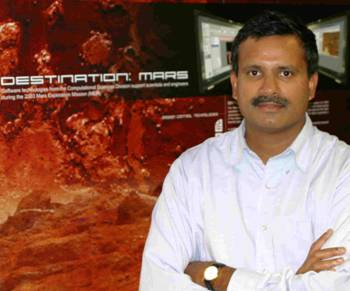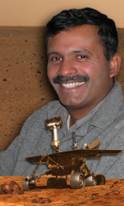 |
||
|
|
|
||||||||||
|
||||||||||
|
bitsaa.org BITS Pilani |
The Quarterly BITSian
|
Interview By Ashish Garg The Quarterly BITSIAN:
Kanna Rajan, (í80) - NASA A Chemistry/Chemical dual degree
holder, Kanna Rajan lead the Software team for the Mars
Exploration Project (MER), unarguably the most ambitious and
complex mission flown by NASA to date. His work in a niche area of
Artificial Intelligence was recognized in appointing him to the
position. He believes his days at Pilani prepared him well for his
work, especially through the extra curricular activities as
CoStAAn and Election Commission Chairman. In this interview he
discusses the future of space exploration, Indiaís
plans for space and the kachoris at BITS. |
Tell us
something about the time you spent at BITS Pilani
I joined BITS in 1980. In those
days we used to have something called the ĎPrep semesterí. The Prep
semester used to be in June, July and Aug.
It was another filter after the Class 12th exam which was used to
determine admission status. We had a very intense three months and at the
end of it we could get to pick our dual for those who were in the
dual-degree program.
In retrospect I found it
interesting as it exposed us freshmen/women to Pilani gently. The Prep
semester allowed us to come in, figure what we want, adjust to the
environment and gave us the Pilani feeling Ė for instance there are
things you do and certain things that you donít as BITSian. The initial
shock of joining Pilani was somewhat alleviated, I must say, by a visit
inside Meera Bhawan in my fresherís period when I was sent there get
ragged!
I started off in Vyas which had
terrible food, but it sort of improved when after I went to Malviya.
Malviya was the feared Bhawan in those days because seniors who were 5
years ahead of us were busy engaging in forbidden substances.
It was a different experience in the company of some very
interesting people.
In retrospect those years in
Pilani were the best years of our lives. My wife continues to be amazed at
how Iíve managed to keep my Pilani alliances alive even after all these
years.
When did you come to the
I came to US in Aug 1986 after
graduating from Pilani. I
joined the
After graduating from UTA in
1990, I worked for two years with the Artificial Intelligence group at
American Airlines in nearby
When I was at NYU, I realized
that a lot of what I was doing was very theoretical. I was keen to use all
this theory to solve real-world problems, which eventually led me to NASA.
Joining NASA was a serendipitous
turn of events. I was looking for a job at that time. AI Magazine had a
posting for a position at NASA Ames. At that time
The funny thing about the
interview itself was it was in a cafť in downtown Mountain View since
Iíd forgotten to get my green card (which I had already at that time) to
get into the base.
When I joined, NASANASA
researchers working on AI were mainly theorists. Fortunately the year I
joined, 1995, was an interesting one because NASA agreed to fly an AI
based control system on-board a spacecraft for the first time.
The agency asked us to prove it
to them that we were capable of the job of controlling a complex
spacecraft by developing a prototype. I was hired to work on that project.
This phase was highly successful. This system was called the Remote Agent
and it still remains the only one of its kind at NASA! From an AI
perspective that was good work and its flight on DS1 a significant
achievement.
Credit:
NASA
What is your
typical day like at NASA?
NASA is a big institution with
many different divisions. My group does applied research in autonomy and
robotics. Its very academic; I
liken it to walking into grad school. The groupís charter is to
essentially build the next generation of control systems for spacecraft.
Now that I lead this effort,
there is a lot of administrative work to do. Apart from that there is
quite some traveling to conferences. I ensure that my group at NASA Ames
works closely with the NASA Jet Propulsion Laboratory (JPL) at Caltech. A
day at NASA for me is fairly chaotic but exciting.
|
Photo credit: UT Name:
Kanna Rajan Position:
Leader, Scheduling & Planning, Mars Rover Exploration Project,
NASA Former
jobs: AI Group, American Airlines; Fermi National
Laboratory Education:
|
Tell us more
about the Rover project?
At any given time, the rover is
doing multiple things and there are some serious energy constraints. The
rover runs on solar power so we need to make sure we do not drain the
battery, or we donít bump into a rock! We have limited resources,
limited time and also some scientific intent behind everything that the
rover does. These constraints mentioned above, could be ďyou cannot take
a picture while you are moving because of power issues in addition to the
fact that one might get blurry picturesĒ. Also we do not want an
overloading of the CPU, which runs only at 25Mhz! So in a sense there is
this tension between the scientistís wanting to do as much as possible
and the operations engineers want to do as little to keep the rover safe.
Our group is responsible for the
MAPGEN system. For MER time and energy are critical elements. The most
crucial is battery, which is a non-linear resource. If we plan too many
activities for the rover to execute, we might be draining the battery; if
we plan too less then we might overcharge and top it wasting the
capabilities of a rover that could have been doing a lot of science. The
MAPGEN software essentially produces a sequence of activities, and then
schedules these activities for the Rover.
Is there
anything you learnt at Pilani that has prepared you for what you do today?
I think so. My hypothesis (which
may or may not be correct) is that Pilani actually prepares you for life
better than most academic institutes in
One of the main things I learnt
at Pilani was the art of dealing with people. Academically I was always
engaged but I was also very active in extra-curricular activities. I was a
CoStAAn for the Department of Controls for the second APOGEE on campus. I
was also the Election Commission chairman in my 3rd year. I had strong
relations with people of my batch even as I was close to a batch junior.
Do you
remember any funny incidents from BITS days.
One funny incident happened
during my 3rd year in Vyas. On the Vyas Bhavan Cultural day I had imbibed
a little too much and then kicked somebodyís door open. This guy was
from a rival camp in an upcoming election. Next morning, G.P. Deshpande
who was the chief warden (and also Mr. Tough-Guy) called me and first
thing he asked me was my GPA. Incidentally my GPA was high and he told me,
ďWith such high GPA why are you fooling around like this?Ē
When we were there, BITS was a
wild place. My BITS life is full of such memories and in terms of bonding
with friends, it was a phenomenal experience .
Any there
other people of Indian origin working on the MER project?
Not that I am aware of.
Did you ever
get a chance to meet Kalpana Chawla?
No.
George Bush has announced ambitious plans
involving Mars. Do you believe man (or at least the
We will get there someday for
sure. We currently have the technology needed to get to Mars from a
research perspective. What we donít have is a viable prototype of a
system to get someone to Mars and get him back. I think within 40 to 50
years itís definitely possibility I believe that this requires more
political will than anything else.
Companies are
applying for licenses to take man to the edge of the atmosphere. Is this
something that will become commonplace in our lifetime?
Absolutely! It will happen within
the next 10 years, maybe 5. There are organizations like www.xprize.org
who are trying to promote sub orbital flights with prizes of up to $10
million. I am sure that within 5-6 years we will have a commercial,
non-governmental sub orbital flight.
India is
planning to spend billions on their space ambitions, yet millions remain
poor and starving. How can we justify investments in our space programs
when the most basic needs remain unmet?
There is a long(er) term view
that one has to think of, when answering such questions. Science in
general always has the tendency to generate unintended (and very often
beneficial) spin-offs and inventions. The personal computer (PC) as we
know it today owes a lot to the work IBM did for the Apollo for example.
IBM kept getting pushed to building smaller and smaller computers, which
finally led to the advent of the PC. That in turn, had a very significant
impact on the
However,

I am not sure about is the point
of the mission to moon. If it is a political or a prestige issue then I
donít think itís worth it. But if there is some scientific basis that
can push science in
There will definitely be benefits
of space research. But if people in
While you
fulfill the dreams of man, you must have some of your own. What would you
like to do in your lifetime?
In the long term, I want to get
to a point where I can help people in the Artificial Intelligence
community to push the state of the art (and practice) something I am very
passionate about. Our community has some very sharp people, who are at the
cutting edge, but the problem is that they are somewhat disconnected with
real world problems. They are working on deep problems in theory and they
want to get into the practical world to solve real problems. This has been
a very difficult thing to do. NASA is one of the very few places were you
can make this transition between the theoretic and practical worlds.
Eventually I guess I would retire
to the hills of
Any advice for other BITSians who want to
enter the realm of Space Exploration. What talents
are needed? What is the career path
like?
There is no specific recipe to
getting into Space Exploration. My advice would be to stick with what you
like. Since Pilani, for instance, I have stuck to a very narrow field of
research namely planning and scheduling, and itís paid off for me. This
may or may not pay off for someone else. But as long as you have the
integrity to say that this is ďwhat I am going to do because I enjoy
itĒ I think things would work out. The most important thing is to like
what you do as a career; not have to do it because of other reasons.
You really need to home in onto
something and follow it. One doesnít need to be an Einstein, but one
does need to focus. So going back to your question, if you want to do deep
space exploration then you aim to go to JPL Caltech. If you want to do
earth sciences related work, you go to NASA Goddard in
Lastly, tell
me something about your family. Do you intend to take them to Pilani?
My wife and I have a 3-year old
kid. I just got back from
I really want to go to Pilani
sometime. The problem is that we go in winter and BITS is closed for
winter vacations during the time.
During
our times, there was this guy Vishwanathji, who used to sell really good
kachories near the swimming pool. And I still remember the samosas and
shikanjiís at Blue Moon, the best Iíve ever had. So Iíd really like
to go back at the very least for the shikanjis and the kachories, not to
mention if I can help BITS in any shape or form. And get my wife and kid
to experience what Iíve been raving about all these years ■
(c) Copyright 2003 BITSAA International Inc.



